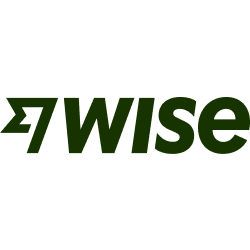Many or all of the products featured here are from our partners who compensate us. This influences which products we write about and where and how the product appears on a page. However, this does not influence our evaluations. Our opinions are our own. Here is a list of our partners and here's how we make money.
International money transfers are a popular practice. Though a bank might seem like an obvious place to use to make an international money transfer, they’re actually the most expensive option, costing an average of nearly 11.5% of the amount you’re sending, according to The World Bank's September 2023 Remittance Prices Worldwide Quarterly report. The typical cost for an international wire transfer sent from the U.S. is $45.
You’ll likely pay lower costs and your recipient will get the money faster by using one of the following licensed money transfer companies instead of your bank. Here are five options for the best way to send money internationally.

Wise
at Wise
Coverage from the U.S.: Over 70 countries (though this number can fluctuate).
Cost: Wise, formerly TransferWise, offers some of the best exchange rates you can find, and upfront fees tend to be lowest if you use a bank account to fund your transfer, typically less than 1% of the transfer amount.
Speed: Bank transfers tend to take days, but same-day delivery is possible for sending to some countries. A transfer using a debit or credit card can arrive within seconds, while a transfer using a bank account can take anywhere from seconds to two business days, depending on the destination.
Transfer limits and options: Sending limits go up to $1 million per transfer, if using a wire transfer to pay Wise. You can also pay with debit card, credit card, Apple Pay, Google Pay or a direct debit (or ACH transfer) from your bank account. Your recipient needs to have a bank account to receive money, regardless of how you fund the transfer.
Customer experience: Wise’s mobile app receives high user ratings and its website's FAQ is easy to find.
» Want more context? Read our Wise review

Member FDIC
Barclays Online Savings Account

4.35%
$0

Member FDIC
EverBank Performance℠ Savings

5.15%
$0
OFX
at OFX
Coverage from the U.S.: More than 190 countries.
Cost: OFX doesn't charge transfer fees regardless of how much gets sent. Its exchange rate markups tend to be around 0.5% to 1%.
Speed: No same-day delivery option from the U.S. OFX generally receives your bank transfer within half a business day and delivers the money to your recipient in another one to three business days, depending on the destination.
Transfer limits and options: The sending minimum per transfer is $1,000, and there’s no set maximum. Transfers can only be made between bank accounts, as opposed to funding with cash, credit card or other options available with some of the providers on this list.
Customer experience: OFX’s 24/7 support line and its website FAQ are helpful. Its apps get high user ratings, too.
» To learn more, see our full OFX review
Xoom
Coverage from the U.S.: Over 160 countries and territories.
Cost: Xoom tends to have low upfront fees, such as $0 to under $5 when you use a PayPal balance or bank account instead of debit or credit card, but exchange rate markups can be over 1%. Xoom still tends to be cheaper than banks’ international wire transfers (see what banks charge).
Speed: Many transfers can arrive within minutes, regardless of the payment method. But it could take up to a few days, depending on factors like banking hours or time zones.
Transfer limits and options: Cash pickup at supermarkets or other locations is a delivery option in some countries. Sending limits vary, but daily transfers are capped at $50,000. You can fund a transfer with a bank account, debit or credit card or PayPal account since Xoom is owned by PayPal.
Customer experience: Phone support is available from 9 a.m. to 9 p.m. ET in several languages, as is assistance via email. The online platform provides clear cost calculators and FAQ, and mobile apps receive high ratings.
» See more: Read our full Xoom review
MoneyGram
at MoneyGram
Coverage from the U.S.: Over 200 countries and territories.
Cost: Upfront fees for transfers funded by bank account tend to be low, but fees for other payment methods tend to be high. MoneyGram’s rate markups vary depending on where you send the money and can surpass 3%.
Speed: Delivery can be within the same day, regardless of payment choice, but can be longer, depending on banking hours and other factors.
Transfer limits and options: MoneyGram maxes out at $10,000 per online transfer and per month but depending on the country you’re sending to, that limit can jump to $25,000 per transfer. It has the advantage of physical locations so people, especially those without bank accounts, can pay in cash and have recipients pick up funds. Its web platform lets you pay with bank accounts and debit and credit cards.
Customer experience: Support by email and live chat is available (and by phone for reporting fraud), and fees, rates and other information can be found online easily. Its mobile apps have solid ratings.
» Want more detail? Read our full MoneyGram review
Western Union
Coverage from the U.S.: Over 200 countries and territories.
Cost: Varies. Fees for transfers up to $1,000 can be under $5 (or more, depending on the funding source and delivery method), but Western Union’s rate markups vary a lot based on the payment type, delivery method and destination country.
Speed: Same-day delivery is possible when you have transfers sent to cash pickup locations and use a debit or credit card (or pay cash in person), though you pay more for the rush. The cheapest transfers require bank accounts for sending and receiving money and can take over a week for delivery.
Transfer limits and options: Western Union’s website varies its transfer limits by country, such as $5,000 to Mexico and $50,000 to India. As one of the biggest transfer providers worldwide, Western Union’s main advantage is its network, especially for sending cash in person and providing cash-pickup delivery options.
Customer experience: There’s phone support and live chat available 24/7, but the website doesn’t make it easy to compare exchange rates and the FAQ aren’t easily found.
» For more details, read our full Western Union review
» Going abroad? See our picks for the best banks for international travel
How to choose among the best ways to send money internationally
When deciding on which provider to use to transfer money internationally, there are a few factors to consider. Here are definitions of money transfer terms and some general advice that can help you choose.
Definitions: Money Transfer Rates
There are three rates that determine how much your money transfer will cost and how much money your recipient will receive.
Exchange rate: An exchange rate is the price of one currency in relation to another currency. For example, if you want to convert U.S. dollars to euros, you would check what one U.S. dollar is worth in euros.
Midmarket rate: The midmarket rate, also called the interbank rate or interbank exchange rate, is the exchange rate that big banks use to swap currencies among one another.
Exchange rate markup: Most providers use an exchange rate markup when pricing your transfer. They give customers an exchange rate that’s the midmarket rate plus an additional percentage, or markup, to make a profit on the transfer. The higher the markup, the less your recipient gets in their currency.
General advice for international money transfers
1. Know how exchange rates work (and how to find the best). One of the ways money transfer providers make money is through exchange rate markups. Most transfer providers won’t give you the exchange rate you’d find on a currency exchange platform like the one at Bloomberg.com or Reuters.com. Those sites just tell you the price of one currency in relation to another, but they are a helpful starting point to know what the best rate looks like this minute. When you check the exchange rate for an international transfer with services like Western Union, focus on the exchange rate markup by looking at the foreign currency amount. The higher it is, the lower the markup is, and the more money your recipient receives.
2. Compare total transfer costs across multiple providers. There are two types of costs: upfront fee and exchange rate markup (see above). Find the provider that has the lowest fee combined with the best exchange rate you can get. Usually online nonbank providers offer cheaper transfers than banks.
3. Avoid paying with a credit card. It’s an option for some providers, but there might be a higher upfront fee and your credit card issuer may tack on costs such as interest and cash advance fees. A transfer paid by bank account directly tends to be a much cheaper (and much slower) transfer. If you need money delivered quickly, use a debit card, which will also incur a lower fee than using a credit card.
METHODOLOGY FOR INTERNATIONAL MONEY TRANSFERS
We analyze seven providers that work in the U.S., focusing on major players in the international money transfer industry, based on market research, experts, cost analysis and U.S. internet traffic.
Exchange rate markups mentioned are based on the analysis of transfers to Germany, India, Mexico and the United Kingdom for $1,000 and $10,000.
On a similar note...













